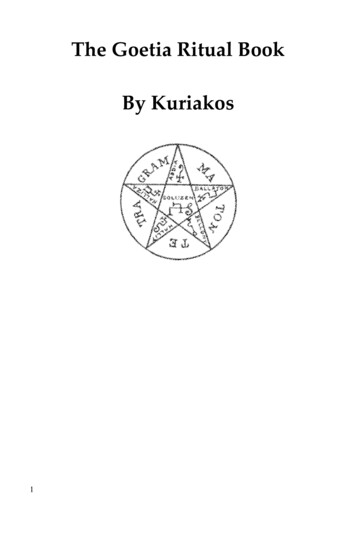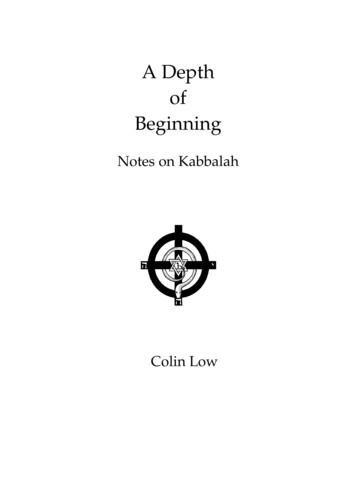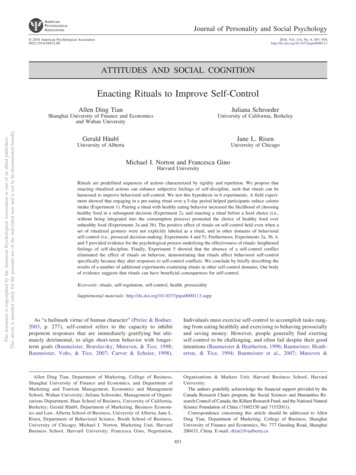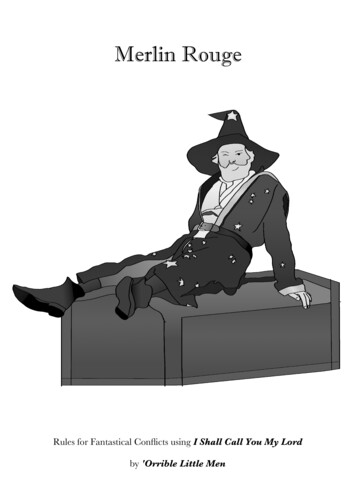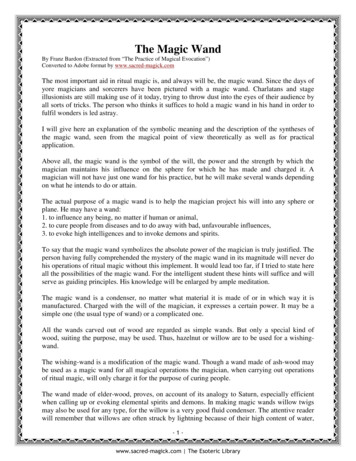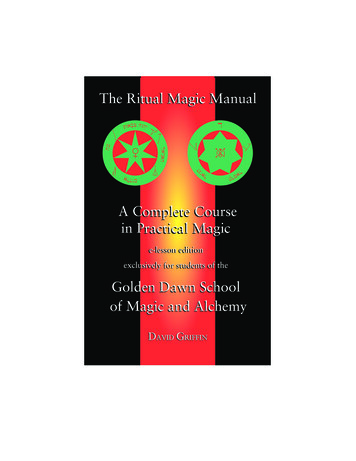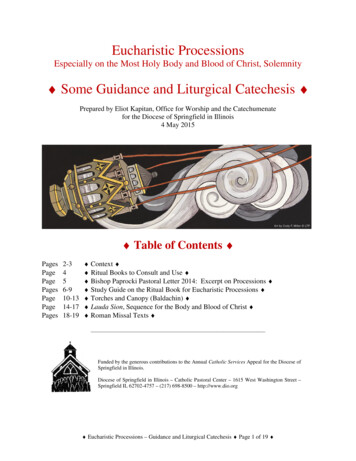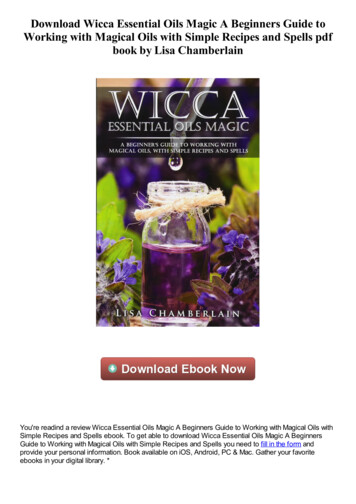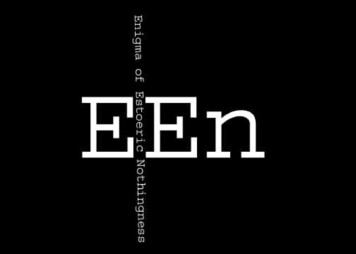
Transcription
The Magical and Ritual Use Of HerbsByRichard Alan MillerContents:Book Cover (Front) (Back)Scan / Edit NotesAbout The AuthorIntroduction 1 - Stimulants Damiana Passionflower Betel Nut Mormon Tea Guarana Kola Nut2 - Depressants Lobelia Scullcap Valerian Root3 - Narcotics Wild Lettuce Wormwood4 - Hallucinogens Calamus Galangal Root Kava Kava Yohimbe Fly Agaric Morning Glory Seed Psilocybe Mushroom Thorn AppleQuick Reference ChartBibliography (Removed)Indexs (Removed)
Scan / Edit NotesNote:This is not strictly a 'new' scan since I did this awhile back. However with better OCR tools now and amore organised system (for making e-books) I have completely re-done this book and further proofedthe text. I decided to release this better version since I will be posting this books companion volume'The Magical and Ritual Use of Aphrodisiacs' which I have not scanned before.Format: v2.0 (PDF - no security)Genera: Herbal / Magic / RitualExtra's: Pictures IncludedCopyright: 1993First Scanned: (Re-done september-2-2002)
About The AuthorRecognizing that science should not and cannot be separated from the welfare of the human being,Richard Alan Miller is a scientist of extensive and multidimensional expertise. Receiving a degree inTheoretical Physics from Washington State University in 1966, he spent over a decade in bio-medicalresearch and development for some of the most prestigious and technically sophisticated corporationsin the United States, including The Boeing Company and E. I. Dupont de Nemours Co. He worked forseveral years in the department of anesthesiology of the University of Washington, incorporating hisskills both in medicine and physics, and has been published in several international journals for hiswork both in physics and parapsychology. He has taught parapsychology for credit in the naturalsciences at several universities and colleges. He has also taught courses in shamanism, magic,alchemy, and growing herbs as a cash crop.In 1972 he formed The Beltane Corporation, now The Beltane Herb Company, specializing in theselling and study of herbs, spices, and books focusing on herbs, health, and the occult. He laterbecame agricultural scientist and buyer for Western Herb Frams, Inc. As a physicist he has inventedseveral critical pieces of farm machinery to assist the small farmer in harvesting and processing. As anagricultural scientist he has developed specific farm plans and crop sources to compete with currentlyimported spices and herbs, and he publishes a newsletter, The Herb Market Report, which isconsidered one of the best on the subject. He is also contributing editor to Acres USA. He continues toresearch and employ the best of highly technical methods in a harmonious and non-injurious way.
IntroductionPurposeTo provide the explorer with concise information on various legal psychotropic botanicals currentlyavailable.OrientationTo provide ritual use of mind-altering sacramental herbs.Ritual is the outward manifestation of the need in man to break the barriers of the ego in order tobecome a part of something greater. It is the visible form of an inward or spiritual grace. Rites arecalculated to arouse the sentiments that support a given goal. Ritual is valuable because1. It organizes experience. The manner in which an experience is "perceived" will determine possibleways that experience might be used. This allows more conscious control of our growth anddevelopment.2. It lends grace and style to action, preventing clumsy uncertainty, wasted energy, and distractions.3. It enhances the general atmosphere by using specific symbolism.In psychology, ritual is considered the celebration of a myth, which is achieved through a carefullyconstructed enactment of the myth. Because ritual is the externalization of something internal, mythhas a more archetypal (*) than logical structure to it. Rituals reveal values at their most fundamentallevel. Man expresses in ritual what moves him most.Therefore: The symbol always originates on the inside and is projected outward.Ceremonies and rituals are the means provided by society for periodically drawing up the energyattached to symbols. As symbols sink back into the unconscious, ritual serves as a technique to bringthem back into a more common awareness.Magic has been defined as "the science and art of causing changes to occur in conformity with will."What this means is that conflict occurs when people are not living their true will. The purpose inlearning magic is to discover that true will (not necessarily desire) and then live it.Therefore: Every intentional act is a magical act.Whenever individuals change their perception of reality, they also change the ways reality can affectthem. This has to do with attitudes, expectations, and projections.Therefore: Whenever individuals take a mind alterant, they are (by definition) performing an act of
magic.Rituals can thus be used to "program" a religious awakening to create a deeper awareness of thespiritual. The art of magic is science combined with ritual. The chemistry of each herb in this bookhas been thoroughly examined to determine how it affects conscious perception of reality. Thisinformation will enable individuals to control their experience, and as a result, give them more controlover who they become.---[*] ". the archetypes, as structural forming elements in the unconscious, give rise both to the fantasylives in individual children and to the mythologies of a people." — C.G.Jung---Some of the materials discussed are quite dangerous. Notes of caution are included because manypeople have already shown interest in experimenting with them. I feel it is important to discuss thesebotanicals, while at the same time making sure their potential dangers are understood.Although I am confident about the accuracy of this information, I cannot assume responsibility for theexperiences of people following these traditions for personal drug use.It is wise to use very small portions at first when experimenting with unfamiliar substances. Thebiochemistry of one person may be different from that of another. Some individuals are allergic (*) tosubstances upon which others thrive. Also, one's body needs may vary at different times. If anyundesirable effects are felt, it is advisable to discontinue use of that substance.If there are no effects, desirable or undesirable, gradually and cautiously increase the quantity of theherb. Experimentation is what this is all about. Spirituality does not lie in what you are doing, butrather in how you do it. There is no greater reflection of true will than personal experience. AsAleister Crawley quoted Rabelais in his Liber al vel Legis, "Do what thou wilt shall be the whole ofthe Law."---[*] An allergic study can be made by scratching the skin with a sterilized pin and a sample of the herbconsidered. Scratches should be one-half inch long and not draw blood. If the scratch creates anirritation within an hour, you will probably experience an unpleasant side effect from the herb inquestion.----
1 - StimulantsDamiana - A sacrament to improve and tone sexuality Family: Tumeraceae.Botanical Name: Tumera diffusa.Synonyms: Mexican damiana.Geographical Location: Tropical parts of the Americas, particularly Texas and Mexico. It isalso harvested in Africa.Habitat: Grows in dry soil; needs sun.Botanical Description: A small shrub with ovate leaves that are broadest toward the top end.The leaves are smooth and pale green on the upper side and smooth on the undersides exceptfor a few hairs on the ribs. The flowers are yellow, arising singly from the axilla of the leaves
followed by a one-celled capsule splitting into three pieces. The flower has an aromatic smelland a bitter taste.HistoryMany women in Mexico have found that a cup of damiana tea taken one or two hours beforeintercourse helps to immerse them in the sex act. It is believed to have a tonic effect upon the sexualorgans and the nervous system. Most effective when used in combination with saw palmetto berries(Serenoa repens) in a 1:1 ratio.ChemistryThe leaf contains 0.2-0.9% volatile oil, 14% resin, approximately 3.5% tannin, 6% starch, and a bittersubstance called damianian.Primary EffectsMild aphrodisiac and marijuana-like euphoria, lasting about an hour and a half.PreparationIn his book, A Manual of Sex Magick, Louis J. Culling describes a damiana drink preparation: Take 2heaping tablespoons of dried damiana leaves and boil them in 1 cup of water for five minutes. Cool,strain, and drink in the evening. He recommends continual use over a two-week period for significantresults.Ritual UseBelow is a fine recipe for an aphrodisiacal cordial of damiana. Soak 1 ounce of damiana leaves in 1pint of vodka for five days. Pour off the liquid, strain, and filter through a conical paper coffee filter.Soak remaining alcohol-drenched leaves in 3/4 pint of distilled or spring water for another five days.Pour off the liquids, strain, and filter as before. Warm water extracts to 160ºF and dissolve in 1/2 to 1cup of honey. Combine alcoholic and aqueous extractions. Age for one month. During the aging asediment will form as the liqueur clarifies. The sediment is harmless but you may wish to siphon theclear liqueur from it. For best results, take 1 or 2 cordial glasses of the beverage nightly. The taste isexquisite.Small quantities of liqueur are excellent for any ritual oriented toward sex magic. Although itschemistry is unknown, damiana can be used as a sacrament to improve and tone sexuality.Note of Caution: Excessive long-term use may be toxic to the liver.
Damiana can make a really fine smoke if used in a waterpipe. For a marijuana-like high, a blendknown as Yuba Gold is:4 parts damiana leaf4 parts scullcap herb1/2 part lobelia herb4 parts passionflower herb1 part spearmint leaf Passion-Flower - A sacrament for the ritual greeting smoke (a marijuana substitute) Family: Passifloraceae (Passionflower family)Botanical Name: Passiflora incarnata.Synonyms: Maypop, grenadille, apricot vine, passion vine.Geographical Location: Native from Virginia, south and west to Florida, Texas, and the WestIndies. Now cultivated throughout the world.Habitat: Light, rich, dry soil.Botanical Description: This herb is a perennial with hairy climbing vines. The leaves havethree to five lobes with finely serrated edges and solitary white flowers containing a purple,blue, or pink crown in the center. The ripe fruit, oval-shaped and orange, is called a maypop.The maypop berry contains many seeds and the yellow pulp inside is sweet and edible.HistoryThe name passionflower, from the Latin passiflora, comes from the symbolic relationship between theanatomical and numerical arrangement of the flowers and the elements of the crucifixion, the passionof Jesus Christ. The finely cut corona in the center of the blossom resembles the crown of thorns; thepetals and sepals symbolize the Apostles.
ChemistryHarmine and related alkaloids. Called a psychic sedative. Isomer harmaline has been tried inParkinsonism. It is a very potent monoamine oxidase inhibitor. (See Yohimbe, Note of Caution)HarminePrimary EffectsWhen smoked, a very mild, short-lasting marijuana-like high occurs. It acts as both a sedative and atranquillizer. In larger quantities, it acts more like a hallucinogen.PreparationUsually smoked in combination with damiana, scullcap, and spearmint or peppermint (for flavor).(See recipe for Yuba Gold)Ritual UseAlchemy has a number of interesting faces. With symbolism, various elements are classified into asystem of qualities. By appropriately mixing these qualities, new elements are created. An examplewould be combining the heat of fire with the wetness of water, thus creating air which is hot and wet.A more contemporary example is: "Although the person had never lectured before, he was excellentbecause he had the qualities of enthusiasm and knowledge about the subject."Imagination is one of the great pointers to reality. It is the creative part which enables us to surviveand "progress." By taking imagination seriously, beyond the level of mere personal fantasy, it tends tostructure itself to major archetypal patterns. Synchronicity is the key. By using tables ofcorrespondences (Liber 777, for example) to project and create the archetype, a literal reality iscreated. We should not separate science and technology from the religious context.The extraction of alkaloids can be seen as an alchemical process. Use ethyl alcohol or any drinking
alcohol. The yield is approximately 1 gram of mixed harmal alkaloids per kilogram of herb. That's alot of doses—and symbolism!Note of Caution: Harmala alkaloids are potent monoamine oxidase inhibitors. (See Yohimbe, Note ofCaution) Passionflower makes an excellent tea to get rid of headaches and insomnia. Betel Nut - A sacrament for stimulation during a long journey or for manual labor Family: Palmaceae (Palm family).Botanical Name: Areca catechu.Synonyms: Areca nut, pinang, siri, supari (Hindu), and ping lang (Chinese).Geographical Location: India, Malaysia, Polynesia, and the South Pacific Islands.Habitat: Light soil with heavy rain.Botanical Description: A slender climbing tree that grows up to 75 feet high, with a ringedtrunk that is usually trained on poles or trellises in a hot, but shady environment. The leafblades grow to be as wide as 3 feet across with many pinnae and many veins.History
In 1930 it was estimated that there were at least 20 million betel chewers in India. One betel palmproduces about 250 seeds or nuts per year and millions of these trees are under cultivation. It is one ofthe world's most popular plants, yet few Western people have ever heard of it. The leaf is convertedinto paper for rolling tobaccos and herbs. Regular use of betel nut, in time, stains the mouth, gums,and teeth a deep red. Asain betel chewers, however, are quite proud of these stains.ChemistryArecoline, a volatile oil, is released from the nut by saliva and lime (calcium oxide). Betel leafcontains chavicol, allylpyrocathechol, chavibetol, and cadinene.ArecolineArecoline is in the same cholinergic alkaloids group as muscarine, found in the divine mushroom,soma. (See Fly Agaric.)Primary EffectsMix 1/2 gram of burnt lime (hydrated calcium oxide) with one betel nut, preferably in a semipowdered form. Place in the side of the mouth like a plug of tobacco for two hours, spitting the salivaoccasionally.Because of the primary effects of arecoline, betel nut is well suited for manual labor. This centralnervous system (CNS) stimulant also makes a journey more vivid because it affects one's perceptionof time. The herb is perfect for weekend journeys to friends in the country, or for ceremonial work onyour land.Ritual UseThe Malayan technique for using betel nut is to mix a mashed or powdered betel nut, some catechugum from the Malayan acacia tree (Acacia catechu), a pinch of burnt lime, and a dash of nutmeg,cardamom, or turmeric for flavor. This mash is then rolled up in a leaf from the betel vine (Piperchavica betel).
These betel morsels are sold on the streets in markets as candy (with no current government control).Note of Caution: Excessive arecoline from either overuse or chewing unripe areca nuts, whichcontain larger quantities of the oil, can cause inebriation, dizziness, and diarrhea. Also, prolonged usecauses damage to the teeth and soft tissues of the mouth. Betel nut is considered an aphrodisiac because it stimulates available energy and elevates moods. It iscurrently used like coffee or cigarettes in this country. Mormon Tea - A stimulant sacrament to improve breathing Family: GnetaceaeBotanical Name: Ephedra nevadensis.Synonyms: Stick tea, desert tea, squaw tea, brigham weed, teamsters tea, and popotillo.Geographical Location: Native to the southwestern United States and Mexico. The variety ofephedra presently used in most commercial preparations is Ephedra gerardiana (Wall.) Satpf.,commonly known as ma Huang. It is imported directly from China. Two similar plants, E.sinica and E. equisentina, are found in northern China from Sinkian to Hopen Province andnorth to outer Mongolia.
Habitat: Prefers deserts and dry mountainsides with good drainage.Botanical Description: The herb has both male and female flowers. The males, with stamens,are found on catkins, while the females, with pistils, rise from a two-leaved flower branchsupported on axillary stalks coming from the stems. The fruit consists of two pistil-likecapsules containing a juicy cone-shaped seed in each capsule. The stems or branches areslender and erect with small leaves somewhat like scales on the stem.HistoryChinese ephedra has been used medicinally for more than five thousand years. In 2700 B.C., ShenMung, the father of Chinese medicine, used the dried roots and stems as a decongestant to treatcoughs, colds, headaches, and fever. Its Chinese name is ma huang.Some species of ephedra were made into a fermented drink and used ceremonially by Vedic andZoroastrian priests for Tantric lunar rites.ChemistryMormon tea contains ephedrine, d-norpseudoephedrine, and tannin. Ephedrine produces most of theeffects of sympathetic nervous system stimulation.Ephedrine Sulfate (Ma Huang)Ma Huang has four times the effect of ephedrine to Mormon tea because pseudoephedrine has lessvascular action, but maintains bronchial effect. They both cost the same per pound.Primary EffectsPowerful decongestant and stimulant. Blood pressure may rise moderately; heart rate and cardiacoutput are increased. Bronchi are relaxed and dilated.
PreparationThe Chinese technique is to bring a large pan of water to boil. Put 1 to 2 ounces of Mormon tea (or mahuang) into the boiling water and cover. Allow to boil for five minutes, then turn down the heat. Threeor 4 cups of the liquid should produce the desired effect.Ritual UseThe breath is considered the source of life in China. Any herb that improved breathing was considereda sacrament. A simple ritual used today involves the herb ma huang and Tiger Balm (an ointmentcontaining camphor):The herb is left on the stove for several days so that fermentation occurs. The water is usually broughtto a boil at least once a day. After the fourth day, the brew becomes quite strong and is considered astimulant. Breathing is improved by placing Tiger Balm on the lip under the nose and inhaling thefumes of ma huang. After doing this for five minutes, drink 3 to 4 cups of the liquid. It will be obviousthat the resultant increase in energy is directly related to more relaxed breathing.Note of Caution: If used in excess (i.e., every day for three weeks), there is the possibility of losingelasticity in the blood vessels and bronchial tubes. Also, Mormon tea and Chinese ephedra producesvertigo, nervousness, and insomnia with prolonged use. It should not be used if one suffers from highblood pressure, heart disease, diabetes, or thyroid problems. Ephedrine is used extensively in cases of asthma to produce bronchial dilation. Epenepherine andEmpirin with codeine contain ephedrine as the principle activant.
Guarana - A sacrament for fasting Family: Sapindaceae (Soapberry family).Botanical Name: Paullinia cupana.Synonyms: Panela supana, Brazilian cocoa, and uabano.Geographical Location: South America, particularly north and west Brazil and Venezuela.Habitat: Tropical jungles.Botanical Description: A climbing shrub with divided compound leaves. The flowers areyellow in an open cluster. The three-celled capsuled fruit contains seeds resembling smallhorse chestnuts. The fresh seeds are flesh-colored and are easily separated from the fruit afterdrying. These seeds are washed and roasted for six hours before use.HistoryMany weight problems in the United States stem from diet and eating habits and patterns. An exampleis the tradition of having three daily meals.An ancient Chinese legend says that once God requested the Ox-god to tell man he needed to eat onlyonce every third day. The Ox-god was forgetful and accidentally told man he needed to eat three timeseach day—hence our myth of three meals per day.This was nine times more food than man needed to eat, and there was no way that quantity of foodcould be produced. As punishment, God made the Ox-god a beast of burden, to serve man and helpproduce the huge quantity of food. The ox is considered sacred in most Eastern countries today.Diet and food consciousness have become so important today that dieting has an air of the ceremonialabout it.
Guarana was first used by the Quaramis, a tribe of South American Indians, for bowel complaints. Itwas also used by Brazilian miners as a preventative for many diseases. Mainly, though, guarana is oneof the main ingredients in a favorite diet beverage in Brazil.ChemistryGuarana falls into the methylated purine group containing 5% caffeine, three times as much as isfound in normal coffee. Guarana is considered the strongest naturally occurring methylxanthine. It hasthe same chemical composition as caffeine, theine, and cocaine, and the same physiological action.Other methylated purines are: 1. Coffee. From Coffea arabica, an Arabian bush; beans contain 1% to 2% caffeine.2. Tea. From Camelia sinensis, an Asian bush; leaves contain 2% to 4% caffeine, theobromine,and theophylline.3. Cacao. From Theobroma cacao, Aztec chocolate; beans contain about 2% theobromine andtraces of caffeine and theophylline.4. Mate. From Ilex paraguariensis, a South American bush; leaves contain 2 1/2% caffeine.5. Kola. From Co/a nitida, an African nut; contains 3% caffeine.CaffeinePrimary EffectsStimulant. Quickens perceptions, causes wakefulness, slows the pulse, suppresses the appetite, and isuseful during long drives or long work periods.PreparationPowder guarana seed with a mortar and pestle or coffee grinder. Prepare like coffee, using the groundsseveral times. Two nuts are recommended per cup. The powder can also be put in capsules andingested.
Ritual UseGuarana seed was usually gathered in October, ground, and then mixed with cassava flour, made intoa paste with water, and dried in the sun. The paste was often shaped into sticks dried over fires. As anenergy source or stimulant, there is nothing better. It also works as an appetite suppressant.MateIn many traditions, the physical body is considered a temple. It is a direct mirror of the state of mind,reflecting whether a person is happy or not. In most societies, fasting has long been considered one ofthe finest disciplines for uniting mind and body. Guarana can be used as a training sacrament forachieving conscious control over the physical body through the technique of fasting. Consider thefollowing schedule as an exercise: 1. First month, fast one day per week, arbitrarily chosen but adhered to rigorously. This meansno food, only water or tea (with guarana). Keep a journal, reporting psychological outlook.2. Second month, fast two days—not consecutively—each week.3. Third month, add a third day of fasting every other week. Observe change in yourpsychology. Develop your own schedule. Also note the tone in your "temple" (your body).Using caffeine speeds up metabolism and kills the appetite.
Note of Caution: Long-term or excessive use of guarana alters the blood sugar. This will causenervousness, insomnia, and possible psychic habituation. Guarana can also be used as a tonic nervine against hangovers, menstrual headaches, and neuralgia. Kola Nut - A sacrament to simulate sexual energies and combat fatigue Family: Sterculiaceae (Cacao family).Botanical Name: Cola nitida.Synonyms: Cola.Geographical Location: Native to West Africa, particularly in the regions of North Ashantiand Sierra Leone.Habitat: Near river beds of tropical jungles.Botanical Description: A tree growing from 40 to 60 feet high that has leaves 6 to 8 incheslong pointed at both ends. It has yellow flowers spotted with purple. The yellowish brown fruitis divided into five segments, of which one to three segments contain seeds. The seeds are flatand are 1 1/2 inches long.HistoryKola nut was an ingredient in Coca-Cola after cocaine became illegal. Today, even kola nut is notused in this "great American drink." It is, however, still consumed as a drink in Jamaica and Brazil, itsprimary attribute being a sexual stimulant similar to cocaine.
The powdered seeds are used extensively as a condiment by the natives of Africa, the West Indies,and Brazil. A small piece of seed is chewed before meals to promote digestion and to improve theflavor of anything eaten after it. The powder is also applied to cuts.ChemistryKola nut contains 3% caffeine, as well as theobromine and kolanin (a glucoside). It also containssome tannin and starch. Caffeine stimulates all parts of the central nervous system, especially thecerebral cortex and medullary center. Kolanin is a source for carbohydrates, the "fuel" needed for thebody's energy. This combination of theobromine and kolanin aids the combustion of fats andcarbohydrates. It also reduces combustion of nitrogen and phosphorus in the body.Caffeine TheobrominePrimary EffectsStimulates and economizes muscular and nervous energies; considered a strong stimulant.PreparationOne tablespoon of kola nut powder in a cup of black coffee is the recommended method of ingestion.You might add some honey, since it is quite chalky. Another technique is to cap the powder in number00 capsules, though the oils will not affect the stomach in the same manner. It is only used this waybecause of its chalklike taste.Ritual UseMost of the original concepts of sex magic were from the earlier Hindu traditions of Tantra. Tantricsbelieved sex contained an energy which could change the physical world. (The psychologicalimplications are covered in Psilocybe Mushrooms, Ritual Use)Psychosexual energy is the principal element behind contemporary western magic. It is the single,
strongest emotion-alterant available that can be disciplined and it is the foundation of Tantra. A pathto the use of this psychosexual power begins by recognizing and then overcoming restrictive sexualprejudices. The first place to start is by cultivating intense gonadal awareness through the conscioustightening of the pelvic region. This is accomplished through deliberate contraction and relaxation ofthe anal and urethral muscles.Two suggested exercises in Sexual Occultism by John Mumford have been used in Tantric yoga forthousands of years in India and the Middle East. These particular exercises can be used as a ritual toheighten orgasms.Exercise One: To control ejaculation and orgasm (Muladhara Bandha).This exercise is a pelvic contraction lock that begins at the anal muscles and spreads forward to thegenitals. The correct feeling of the anal lock is like the sensation you feel when you retain an enemaor hold back the passage of stool from the bowel. The method: 1. Sit erect in a comfortable position, hands palm-up on thighs.2. Focus attention on anal region. Begin with an awareness of the chair exerting pressure upagainst your behind. Pinpoint consciousness to anus.3. Inhale one-half lungful of air, swallow, and hold breath.4. Slowly contract the anus while holding breath. Continue to hold breath.5. Women should spread the pelvic area forward from the anus until a distinct twitch is felt inthe vaginal lips. Men should spread the pelvic region forward from the anus until a distinct pullis felt on the testicles.6. Now release pelvic contraction totally. Inhale and then exhale fully.7. Repeat ten times when first practicing this exercise. Gradually increase to fifty repetitionsper exercise period.The advantages of this exercise are as follows: 1. It tightens slack vaginal walls in women, and it reduces tendency for premature ejaculationin men.2. It sends a blood flush to the urogenital system.3. It tones anal muscles, which can prevent and even cure hemorrhoids and other analdisorders.4. It awakens the Muladhara chakra.Exercise Two: To increase erectile potency and clitoral sensitivity (Vajroli Mudra).This exercise involves the urethral sphincter closure, with which you cut off the flow of urine inmidstream while voiding. As a preliminary step to this exercise, drink several pints of water or beeron an empty stomach. In one hour empty the bladder. As you do, practice cutting off and restrainingthe urine flow at least a dozen times while the bladder drains. The method: 1. Sit erect in a comfortable position, hands palm-up on thighs.
2. Focus attention on urethral sphincter. This is below the clitoris for women and at the base ofthe penis in men.3. Inhale one-half lungful of air, swallow, and hold breath.4. Contract the urethral orifice exactly as if cutting off the urine flow. At the same time, pull upon the lower abdomen, as if attempting to suck your genitals into the pelvis. Relax contractionand repeat as many times as possible while holding your breath. Allow sexual excitement tooccur.5. Cease contractions, relax abdomen, inhale, and then exhale fully.A woman may check to see whether she is performing the exercise correctly by inserting one or twofingers into the vagina during the exercise. If performed correctly, contractions should cause thevagina to close on the fingers.A man may perform the exercise naked in front of the mirror and watch to see whether the head of thepenis twitches or elevates slightly with each contraction.The advantages of this exercise are as follows: 1. It increases clitoral sensitivity in women and erectile potency in men.2. It sends a blood flush to the urogenital system.3. It tones the urethral sphincter, curing urinary stress incontinence.4. It awakens the Svadhisthana chakra.Muladhara Bandha should be followed by Vajroli Mudra daily, starting with ten of each. You shouldadd five of each per day each week until you are doing sixty of each per day.These exercises
more organised system (for making e-books) I have completely re-done this book and further proofed the text. I decided to release this better version since I will be posting this books companion volume 'The Magical and Ritual Use of Aphrodisiacs' which I have not scanned before. Format: v2.0 (PDF - no s
